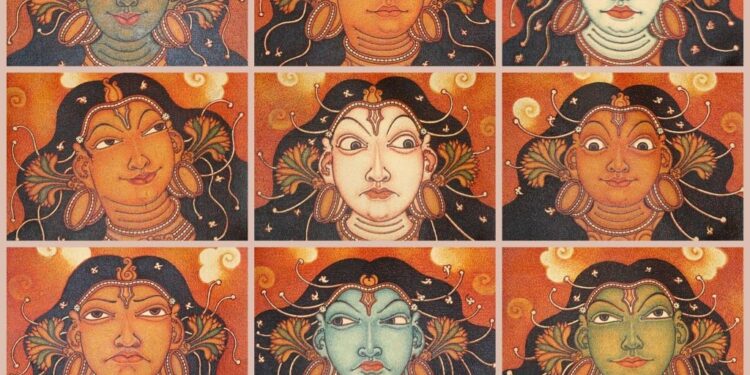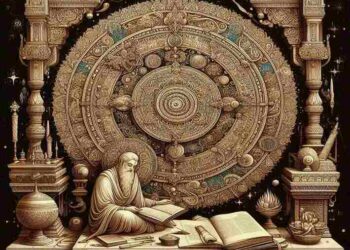Introduction
Alankara And Rasa Theory In Indian Aesthetic Notes Two key ideas—Alankara and Rasa—form the basis of the ancient Indian tradition of aesthetics, which is firmly ingrained in its literature, art, dance, music, and theater.
Both of these ideas have impacted Indian literature, visual arts, philosophy, and performing arts. This essay will explore the fundamental ideas of Rasa (aesthetic sensation or flavor) and Alankara (literary ornamentation), their importance in Indian aesthetics, and how they have shaped our perceptions of beauty, art, and emotions.
The Natya Shastra by Bharata Muni and the Kavyalankara treatises on poetry and literary embellishment are the two main works that explain these beliefs, which are firmly rooted in classical Indian traditions. We will look at how these ideas have changed throughout time, how they have been used in different kinds of art, and how they have continued to shape contemporary Indian aesthetics.
Alankara Theory: Literary Ornamentation and Aesthetic Expression
The term Alankara originates from the Sanskrit word “Alankara,” meaning ornament or decoration. In classical Indian aesthetics, Alankara refers to the devices or techniques used in literature and art to enhance its beauty, structure, and emotional impact. It is often equated with “figurative language” or “stylistic devices” that elevate the expressiveness of a work, whether in poetry, prose, drama, or visual arts.
1. The Importance of Alankara in Classical Indian Aesthetics
Alankara And Rasa Theory In Indian Aesthetic Notes In the context of Indian poetry, Alankara is not merely a decorative addition but a vital mechanism for conveying deeper emotional, philosophical, and spiritual meanings. Ancient scholars like Bharata Muni (in the Natya Shastra) and Kuntaka (in his work, Vakrokti), emphasized that Alankara transforms an ordinary composition into something profound and impactful.
- Alankara in Literature: In literary terms, Alankaras serve as embellishments that can be applied to words, verses, and phrases to enhance meaning and feeling. Classical scholars like Bharata, Bhamaha, and Vamana categorized various Alankaras such as Metaphor (Upama), Simile (Anuprasa), Alliteration (Shlesha), and Hyperbole (Atishayokti). These figures of speech not only contribute to the artistic quality of the work but also amplify its emotional or intellectual appeal.
- Alankara in Drama and Performing Arts: In classical Indian drama (as described in the Natya Shastra), Alankaras play an essential role in conveying emotions, character development, and thematic elements through language, costumes, and gestures. The use of ornamentation is also central in forms like Kathakali, Koodiyattam, and Bharatanatyam, where gestures and expressions are enhanced to convey deep emotions and philosophical undercurrents.
2. Types of Alankara
Alankara And Rasa Theory In Indian Aesthetic Notes Alankara in Indian aesthetics is classified into two broad categories: Rupa-Alankara (ornamentation of form) and Artha-Alankara (ornamentation of meaning).
- Rupa-Alankara (Form-based Ornamentation): This involves the embellishment of visual or sensory appearance, using devices like Metaphors, Similes, and Symbolism. These devices are employed to create vivid imagery and evoke powerful emotions in the audience.
- Artha-Alankara (Meaning-based Ornamentation): This focuses on the depth and philosophical meaning behind words or expressions. It includes Hyperbole, Irony, Paradox, and Allusion, where the surface meaning is enhanced by deeper or multiple interpretations.
Rasa Theory: The Essence of Aesthetic Experience
Alankara And Rasa Theory In Indian Aesthetic Notes The concept of Rasa is at the heart of Indian aesthetics, particularly in the realms of literature and performing arts.
Rooted in the Natya Shastra, Rasa refers to the aesthetic flavor or emotional experience that art—whether in drama, dance, music, or literature—evokes in its audience. Rasa is the result of the interplay between the Bhavas (emotions of the characters or performers) and the Vibhavas (stimuli or conditions that provoke emotions).
1. The Origin of Rasa in the Natya Shastra
Alankara And Rasa Theory In Indian Aesthetic Notes In the Natya Shastra, Bharata Muni introduced Rasa as a way to understand how different emotions are conveyed through performance. According to him, the emotional engagement of the audience is the ultimate goal of any dramatic presentation.
- Bhavas are the emotional states expressed by characters, while Rasas are the emotions felt by the audience. The audience experiences the Rasa through the portrayal of Bhavas on stage, conveyed through Abhinaya (acting) and other performance elements like music, gestures, and costumes.
- The Eight Principal Rasas: According to the Natya Shastra, there are eight primary Rasas, each corresponding to a particular emotion that the audience experiences during a performance. These are:
- Shringara (Love or Beauty): Represents romantic love or aesthetic beauty.
- Hasya (Laughter): Evokes joy and laughter.
- Karuna (Compassion): Conveys sorrow and empathy.
- Raudra (Anger): Represents rage or fury.
- Veera (Heroism): Evokes courage or bravery.
- Bhayanaka (Fear): Stimulates fear or anxiety.
- Bibhatsa (Disgust): Produces feelings of revulsion.
- Adbhuta (Wonder): Creates awe or amazement.
- Sthayi Bhavas: These are the permanent emotional states of the characters in a performance, which act as the root of each Rasa. These can range from love to fear, anger, or wonder.
2. The Role of Rasa in Literature and Performing Arts
Alankara And Rasa Theory In Indian Aesthetic Notes In literature, Rasa is the emotional flavor that a poem, story, or drama evokes in the reader. Classical Indian literature, particularly Sanskrit poetry, employs techniques of rasa to evoke emotional reactions, deepen meaning, and heighten the engagement of the reader.
In performing arts, Rasa theory is practically applied to drama, dance, and music to create an immersive, emotional experience for the audience. Actors, dancers, and musicians are trained to convey Bhavas through Abhinaya (acting) and Angika (physical expression), which combine to produce the desired Rasa.
The Interplay of Alankara and Rasa
Both Alankara and Rasa are foundational to Indian aesthetics, yet they complement each other in different ways. While Alankara is primarily concerned with the ornamentation of language and form, Rasa delves deeper into the emotional experience of the audience.
- Alankara and Rasa in Poetry: In classical Indian poetry, Alankaras like Metaphors or Similes enhance the depth of the emotions expressed, thus intensifying the Rasa. For instance, a well-chosen metaphor may evoke a deeper sense of Shringara (love) or Karuna (compassion) in the reader.
- Alankara and Rasa in Drama: In classical drama, Alankaras enhance the portrayal of Rasas through the language and gestures of the actors. A well-placed metaphor can intensify the emotion being conveyed, making the Rasa felt more strongly by the audience. The visual beauty of a well-executed performance also adds to the experience of Rasa.

Conclusion
Alankara And Rasa Theory In Indian Aesthetic Notes Indian aesthetics is embodied in the philosophies of Alankara and Rasa, which have a profound impact on how art is produced, viewed, and valued.
Rasa establishes a direct emotional connection between the artwork and the viewer, whereas Alankara improves a work’s beauty and emotional appeal by its embellishment of words. They enhance literature, theater, dance, and music collectively, becoming the foundation of Indian artistic tradition.
Both ideas still influence modern Indian art forms, and their combination guarantees that traditional Indian aesthetics will continue to be a vibrant, dynamic influence on contemporary artistic endeavors. The interaction of Alankara and Rasa continues to influence audiences’ emotional and philosophical experiences through literature, the performing arts, and visual representations, so confirming the eternal relevance of Indian aesthetic theory.
Read more
FAQ Section
1. What is the relationship between Alankara and Rasa?
Alankara refers to literary ornamentation that enhances the meaning and emotional appeal of a piece of art. Rasa, on the other hand, is the emotional flavor experienced by the audience. While Alankara works to beautify the expression, Rasa focuses on the emotional response it evokes.
2. How many Rasas are there, and what are they?
There are eight primary Rasas in classical Indian aesthetics:
- Shringara (Love or Beauty)
- Hasya (Laughter)
- Karuna (Compassion)
- Raudra (Anger)
- Veera (Heroism)
- Bhayanaka (Fear)
- Bibhatsa (Disgust)
- Adbhuta (Wonder)
3. How does Alankara contribute to emotional experiences in art?
Alankara uses literary devices like metaphor, alliteration, and simile to enhance the emotional depth of a piece. These devices amplify the emotional intensity of the narrative, contributing to the Rasa that the audience feels during the performance.
4. What is the significance of Rasa theory in Indian performing arts?
Rasa theory plays a crucial role in ensuring that the audience connects emotionally with a performance. It helps in structuring the emotions that the performance aims to convey, providing a framework for actors and performers to create a deep, emotional experience for the audience.
5. Can Rasa be experienced in literature alone?
Yes, Rasa can be experienced in literature alone, especially in poetry and prose, where the emotions conveyed through words and literary devices lead the reader to experience a particular Rasa.
















